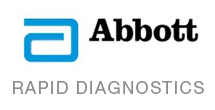Shop assays and controls to perform flu tests quickly and effectively, including A and B tests, A and B card 2 tests, and A and B 2 tests, plus test kits and more.
Flu Testing
Influenza or the flu is a contagious respiratory illness that infects the nose, throat, and lungs. Influenza A and B viruses routinely spread in people and are responsible for seasonal flu epidemics each year. Influenza A viruses are known to cause flu pandemics.
Symptoms
Influenza can cause mild to severe and even fatal illness. People with the flu may have some or all these symptoms: fever or chills, cough, sore throat, runny or stuffy nose, muscle or body aches, headaches, fatigue, and vomiting and diarrhea (more common in children).
Flu viruses seem to spread mainly by tiny droplets created when sick people cough, sneeze, or talk. One can spread flu to someone else while or before they know they are sick. People are most contagious in the first 3 to 4 days after illness onset, which occurs from one to four days after exposure.
Who and When to Test
Although flu testing is not required to make a clinical diagnosis, especially when seasonal influenza A and B viruses are circulating locally. However, flu testing can inform clinical management decisions about antiviral treatment, the need for other diagnostic tests, or initiate infection prevention and control measures.
Flu tests are recommended when admitting patients with suspected influenza to hospital. During outbreaks in hospitals, long-term care facilities, cruise ships, boarding schools, and summer camps, testing can help determine whether influenza is the cause.
Influenza Virus Tests
Common tests for flu are rapid influenza diagnostic tests (RIDTs) and rapid molecular assays.
Rapid Diagnostic Tests for Influenza
RIDTs can detect parts of the virus (antigens) that usually stimulate an immune response and produce results in about 10 to 15 minutes. RIDTs vary in their ability to detect flu viruses and appear to better detect flu in children than adults. During an influenza outbreak, a positive rapid flu test is likely to indicate infection.
Rapid Molecular Assays
Rapid molecular assays detect the genetic material of the virus, also produce results in 15 to 20 minutes, but are more accurate than RIDTs. These assays have high sensitivity (90 to 95%) and specificity. Several other more accurate and sensitive flu tests must be performed in hospital or public health laboratories. FDA-cleared rapid molecular assays produce results in approximately 15 to 30 minutes, and some are CLIA-waived for use at the point of care (POC).
Other Molecular Assays
Flu tests that use reverse transcription polymerase chain reaction (RT-PCR) or other molecular techniques identify the viral RNA or nucleic acids in respiratory specimens with high sensitivity and specificity. Some can detect and discriminate between influenza A and B infections and other tests can identify seasonal influenza A virus subtypes.
Culture and Serology Assays
Neither viral culture nor serologic (antibody) testing is recommended for diagnosing acute illness. The results of these tests are often used for surveillance, antigenic characterization of new seasonal influenza A and B virus strains, research, or public health investigations.










